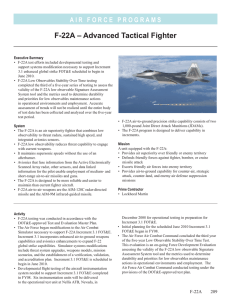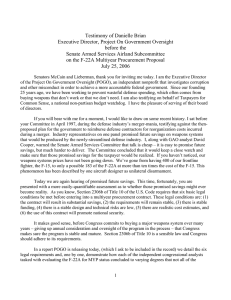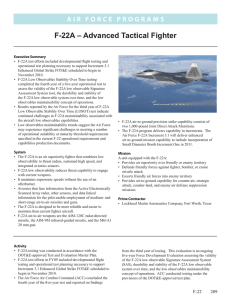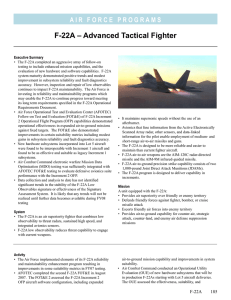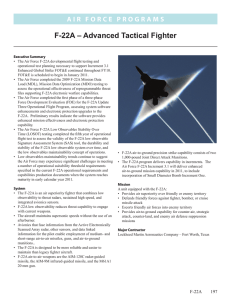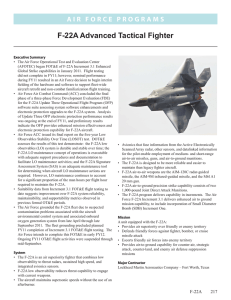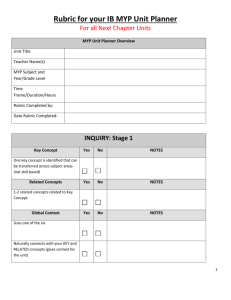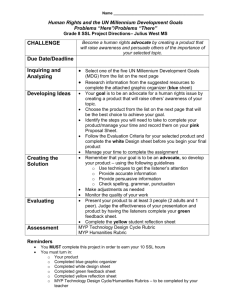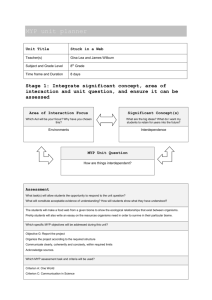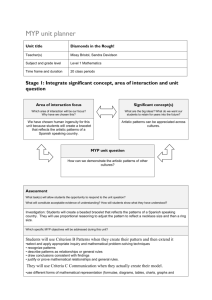DEPARTMENT OF THE AIR FORCE AIRLAND SUBCOMMITTEE UNITED STATES SENATE
advertisement
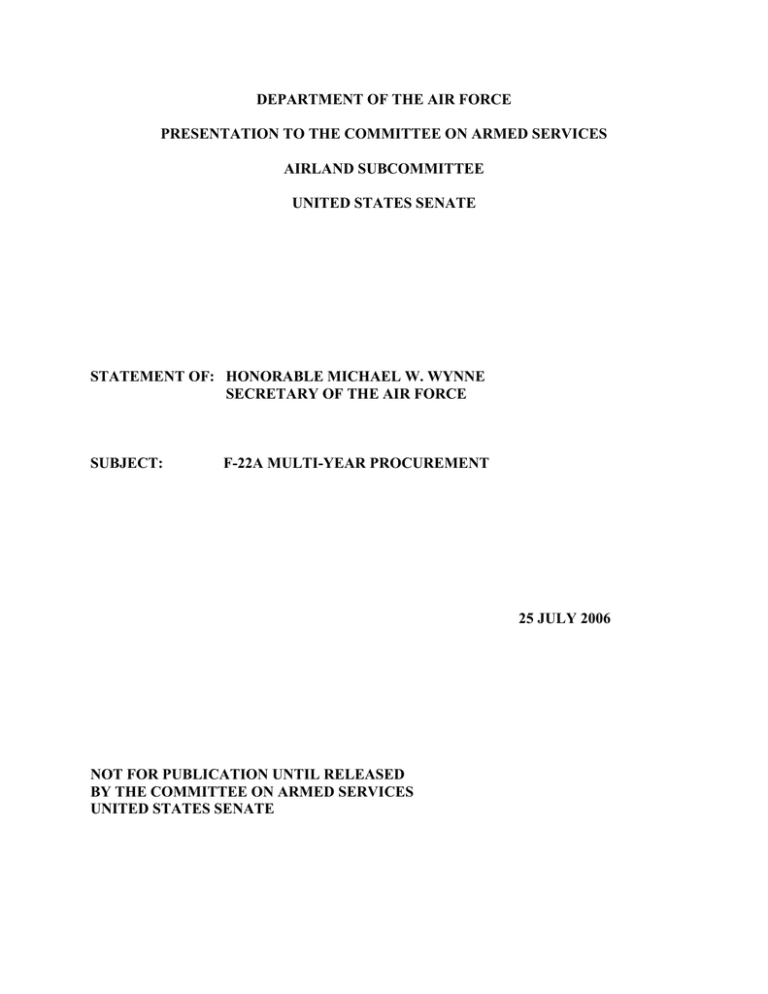
DEPARTMENT OF THE AIR FORCE PRESENTATION TO THE COMMITTEE ON ARMED SERVICES AIRLAND SUBCOMMITTEE UNITED STATES SENATE STATEMENT OF: HONORABLE MICHAEL W. WYNNE SECRETARY OF THE AIR FORCE SUBJECT: F-22A MULTI-YEAR PROCUREMENT 25 JULY 2006 NOT FOR PUBLICATION UNTIL RELEASED BY THE COMMITTEE ON ARMED SERVICES UNITED STATES SENATE Mr. Chairman and distinguished members of the committee, thank you for the opportunity to appear before you today to reiterate the benefits of the F-22A and the Multi-Year Procurement (MYP) strategy. Our joint warriors are the best in the world. However, they can only be as effective as the tools we give them. Within today’s fiscal constraints, we must fight the Global War on Terror (GWOT) and protect the homeland while transforming the force and maintaining an appropriate level of risk. The Air Force is committed to balancing the health of today’s force with the modernization and recapitalization necessary for the capabilities of the future. The Air Force appreciates all the support this committee has provided to the warfighter and the ongoing operations around the world. Our primary fighter modernization and recapitalization program is the F-22A Raptor. The F-22A is operational today and ready for combat. The F-22A is a 5th generation fighter aircraft that delivers Joint Air Dominance to counter persistent and emerging national security challenges. Given its vast improvements in every aspect -speed, all-aspect stealth, integrated avionics, maneuverability, supercruise, and an adaptable architecture -- the F-22A is America’s insurance policy against future threats to Joint Air Dominance and represents a best value capability for the American taxpayer. The F-22A is the only aircraft in the world that ensures air dominance and operational access for the entire Joint Force. It guarantees an asymmetric advantage the U.S. surface forces have enjoyed for over 50 years -- freedom from attack, freedom to maneuver, freedom to attack. Fourth generation fighters (F-15, F/A-18) are able to survive and operate against legacy threats, such as SA-3s, SA-6s, but are overmatched against newer, currently fielded surface-to-air systems such as the SA-10, SA-20, and aircraft such as the F-10, as well as potential future threats such as the SA-21. The F-22A can autonomously complete the kill chain against all current and projected threats. The F-22A delivers unmatched lethality and survivability for gaining and maintaining air dominance – the number one, must have requirement to successfully conduct joint and coalition operations across the spectrum of conflict. The F-22A achieved an 80:1 kill ratio against legacy 4th generation fighters in joint exercise NORTHERN EDGE (NE) 2006 in Alaska. F-15s & F-18s had an 8:1 ratio. The F-22A joint integration and multi-role capability was demonstrated in NE06 as it seamlessly integrated with Joint Special Operations Forces. In addition, F-22A maintenance reliability during NE06 was 97%, flying 102 of 105 sorties. The F-22A is the only weapons system with the unique combination of air, ground, and non-traditional ISR capabilities that enable operations across the full spectrum of conflict, including Homeland Defense and irregular and unconventional warfare. The F-22A program emerged from early development challenges to demonstrating success after success. Based upon the F-22A’s demonstrated design stability, the Office of the Secretary of Defense granted approval for the F-22A to enter Full Rate Production in April 2005. In December 2005, the F-22A achieved initial operational capability (IOC) having successfully completed all developmental testing, and initial and follow-on operational test and evaluation. Air Force Operational Test and 2 Evaluation Center report stated, “F-22 is mission capable in the air-to-ground role.” Currently, there are 74 F-22As delivered, operating from four Air Force bases to include 34 combat-coded aircraft at Langley AFB VA. The F-22A on-schedule deliveries continue at a rate of approximately two per month. Its performance continues to meet or exceed key performance parameters and spiral modernization will further enhance its air-to-air and air-to-ground target engagement capability. To support the Quadrennial Defense Review (QDR) and preparation of the FY07 President’s Budget (PB), the Department performed a Joint Air Dominance (JAD) study. The JAD study examined options for varying levels within the strike fighter mix. The Department looked at the war scenarios and cost implications of buying fewer variants of F-35s, increasing and decreasing the number of F-22As, and buying more legacy aircraft at the expense of fewer 5th generation platforms. The results of these analyses directed the Air Force to “restructure the F-22A program and extend production through FY10 with a multi-year acquisition contract to ensure the Department does not have a gap in the 5th generation stealth capabilities.” As a result, the FY07 PB added $1.05B to the Future Year Defense Plan (FYDP) to procure a total of 183 F-22A aircraft and requested Congressional authority for a MYP for up to 60 F-22A aircraft (20 per year in Lots 7, 8, and 9) and a companion MYP for the F119 engines. The Air Force has long maintained that 381 Raptors will ultimately be required to meet the needs of the warfighter. This number of F-22As provides adequate capability to meet national security requirements to defend the homeland and support two near-simultaneous major combat operations, or their equivalent, with acceptable risk and a sustainable operations tempo. However, the QDR analysis reflected the need to address competing defense priorities and fiscal realities. As a result, 183 F-22As is the current program of record. On 16 May 2006, the Air Force submitted the MYP justification package to the congressional defense committees. Based on independent analysis, the Air Force justification shows that the proposed F-22A MYP meets all requirements of subsections (a)(1) through (6) of section 2306b of Title 10, USC, including a substantial savings of approximately $225 million. The Air Force has demonstrated readiness to enter into the MYP by successfully accelerating production deliveries of 37 F-22A aircraft between 2004 and 2006 to return the program to the original contract schedule while achieving an overall reduction in the unit flyaway costs of over 23% over the same time period (Lots 3-5). Recently the GAO released a report that raises questions about whether the proposed F-22A MYP meets the six criteria required by 10 U.S.C. 2306b. The GAO expresses particular concern over three criteria relating to the existence of substantial savings, the expectation of future funding requests as required to avoid contract cancellation, and the presence of a stable design without excessive technical risks. The proposed F-22A MYP meets all three of these criteria: 1. Substantial savings: A multiyear procurement over three production lots offsets cost increases resulting from reductions in the previous planned annual 3 production rate. Implementation of the proposed MYP contract will yield significant cost savings/cost avoidance over a series of successive single year procurements. The Institute of Defense Analyses' (IDA) independent business case analysis (BCA) estimated the cost to purchase 60 F-22A aircraft and associated engines in three lots under a MYP contract, and the cost to purchase 60 F-22A aircraft and associated engines in three annually procured lots. The BCA also described the benefit of MYP to the defense industrial base, allowing prime contractors to enter into longer-term agreements with suppliers, with resulting improvements in efficiency, training, and tooling. The Air Force and DoD consider the independently verified savings estimate of $225M or $3.75M per aircraft over three year to be substantial. This cost savings per aircraft is comparable to the $3.82M per aircraft for F/A-18 E/F MYP. The Department’s decision to extend the F-22A production line one year by adding Lot 9 without substantially increasing the total program quantity reduced the previously planned quantities of Lots 7 and 8. While this did affect previous estimates of the unit cost for Lots 7 and 8, this decision was necessary to stabilize the 5th generation fighter industrial base, smooth the transition to F-35 production, and preserve future investment options. This decision is unrelated to the proposed MYP contract and does not affect compliance with the Title 10 requirements for substantial savings as compared to annual contracts for the same quantities. 2. Stability of funding requested: The Air Force is committed to fully fund and procure all 60 aircraft through the proposed MYP. This commitment was reaffirmed by the DoD in the QDR decision to continue the F-22A program and emphasizes the criticality of the F-22A to overall DoD planning. 3. Design stability: The development program for the F-22A is complete and the design is stable. F-22A Initial Operational Capability was declared on 15 December 2005. The F-22A has demonstrated over 14,000 developmental test, training and operational flight hours. The existence of a separate and ongoing modernization program does not affect this demonstrated design stability. Like all weapon systems, the F-22A will continue to undergo a modernization program as long as it is in the Air Force inventory. MYP has been approved under similar circumstances for candidate programs with anticipated upgrades, including the F/A-18E/F and UH-60 programs. The F-22A has already proven its air to ground capabilities and as recently as June 2006, the F-22A demonstrated a 34 of 34 success rate while dropping precision munitions. In addition to the criteria above, the proposed F-22A MYP meets the remaining three criteria as well: 4. Stable Requirement: The F-22A requirement has been consistently validated and remains a top Air Force priority. The F-22A Operational Requirements Document, 304-83-I/II/IIIA, dated 17 February 2004, was approved by the Joint Requirements Oversight Council and signed by the Chief of Staff of the Air Force. The QDR supports restructuring the F-22A program and extending production through CY2011 with a multiyear acquisition contract to ensure the Department does not have a 4 gap in the production of its 5th generation tactical fighter aircraft. The FY07 PB documents this decision, and requests funding to support the planned fleet size of 183 aircraft. The F-22A MYP proposes a constant production rate of 20 aircraft per year for three years. This requirement will remain unchanged. Procuring an aircraft with a stable requirement under a multiyear procurement enables better use of limited taxpayer resources. 5. Realistic Cost Estimate: The FY2005 Defense Appropriations Conference Report directed that a Federally Funded Research and Development Center be tasked to conduct an Independent Cost Estimate (ICE) of the F-22A aircraft production program to recalibrate F-22A cost models. IDA completed the ICE and provided a better understanding of F-22A procurement costs. The program’s cost estimates have also been closely scrutinized by the OSD Cost Analysis Improvement Group and the Air Force Cost Analysis Agency. The estimated cost of the F-22A MYP and the associated savings were independently verified by the DoD chartered IDA BCA study. While most MYP estimates are conducted as internal service estimates, the F-22A MYP estimate was independently verified. 6. Promotes National Security: The F-22A is the Air Force’s highest priority acquisition program. There is no alternative aircraft in production offering comparable capabilities to the F-22A. The F-22A is a complex weapon system with over a decade of development, and represents the best option to replace legacy fighters dedicated to air-to-air, Suppression of Enemy Air Defenses, Destruction of Enemy Air Defenses, and Homeland Defense. With its unmatched combination of stealth, integrated avionics and supercruise, the F-22A is the keystone of the Air Force’s Global Strike concept of operations. The F-22A’s dominant combat capabilities will provide U.S. forces with overwhelming air superiority in any scenario, and its robust employment capabilities (both air-to-air and air-to-ground) will afford joint combatant commanders with options for asymmetric engagement that do not exist with legacy fighters. Procurement of the F-22A through the proposed MYP supports the objectives of the National Security Strategy and greatly enhances the effectiveness of the joint force. The F-22A is ready to defend America’s global interests with its formidable capabilities and is critical for national security as indicated from recent studies. Congressional approval of the proposed MYP for the F-22A to begin in Lot 7 is essential not only to achieve the substantial savings of $225M over the next three years, but also to stabilize America’s 5th generation fighter production supplier base to provide a smooth transition to the production of the F-35. I look forward to working with this Committee to best satisfy our warfighter needs in the future. 5
